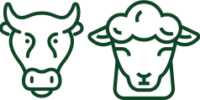The cultivation of the specific crops (wheat and olive) and the breeding of the specific animals (cows and sheep) are crucial for food sufficiency and security, while affecting important sectors of the agricultural economy, as well as agricultural income. Therefore, ensuring the continuation of these agricultural activities by protecting them from climate change impacts is a serious challenge for the future for all those involved in these activities. The implementation of the present research project aims to serve exactly this challenge.
ABOUT THE PROJECT
Climate change and
agricultural economy,
food efficiency and security
The climate projections will be produced by applying the high-resolution regional model WRF. The present and future levels of water stress and heat stress will be calculated and the results will be comparatively assessed to estimate changes in stress levels that are projected to occur in the future.
The project has a strong interdisciplinary and collaborative nature and involves researchers with experience in the topics it deals with (application of climate models and evaluation of their results, monitoring and evaluation of water stress and heat stress, investigation and proposal of climate change adaptation measures).
Furthermore, the project supports the "One Health initiative" approach, which is one of the two pillars of the thematic area to which it was submitted.
SPECIFIC TOPICS
Topics of the project

Project's
Objectives,
Necessity &
Challenges
The project aims to produce future climate projections and exploit them to estimate quantitatively the change in stress that crops (wheat and olive) and livestock (cows and sheep) will experience in Greece by applying water and thermal indices, respectively.
Favourable and unfavourable areas for cultivation and animal husbandry will be detected and guides for crop and livestock farmers will be produced. The Weather Research and Forecasting (WRF) model will be used as a high-resolution regional climate model in order to simulate future climate conditions for the whole country (Greece).

WHEAT
Wheat is one of the most important grains worldwide contributing about 29% of the world's food supply. Throughout the world, wheat occupies 15% of the cultivated land, while in Greece it occupies approximately 25%. ... Reduced rainfall and increased temperatures that can occur as a potential impact of climate change could induce significant impact on global wheat production, causing disproportionately high yield declines. Since wheat is mostly grown as a rain-fed crop, the level of yield loss depends on the duration and severity of drought stress and the phenological stage during which the crop is affected.

OLIVE
The European Union is the largest producer, consumer and exporter of olive oil. The EU produces around 67% of the world's olive oil, with most of the growing areas being located in Mediterranean European countries. ... Greece is the third largest olive producing country in the world, after Italy and Spain. In terms of quality, however, Greece ranks first in the world, as over 70% of Greek olive oil production is "extra virgin olive oil". Olive is considered drought-resistant cultivation with a low reduction in yield after very severe water stress conditions. However, similar to wheat, extended drought seasons in extremely sensitive phenological stages, such as flowering and fruit set, occur strongly reduction in fruit yield. Additionally, rainy periods accompanied by relatively high temperatures at the beginning of summer or in September contribute to the growth of the dacus population, while heavy rains in the spring remove the pollen, resulting in lower fruiting rates.

COWS & SHEEP
The livestock sector is a key pillar of the Greek economy, producing food of high nutritional and biological value, thus contributing significantly to the country's national product. Livestock production is of particular economic, social, and environmental value, as it is a multifunctional activity that utilizes mountainous and disadvantaged areas of the country, which are unsuitable for other uses. ... The importance of livestock production in the country's development is also indicated by the fact that it contributes 29.7% of the total gross value of agricultural production. Sheep and goat farming is the most important branch of animal production in Greece. At the European level, Greece is the first country in the number of reared goats and fourth in the number of reared sheep. Climate conditions affect animal health and welfare. A poor thermal environment can affect the incidence and severity of certain diseases, as well as the animals' thermal comfort, growth rate, reproductive efficiency, the milk yield and overall performance.





